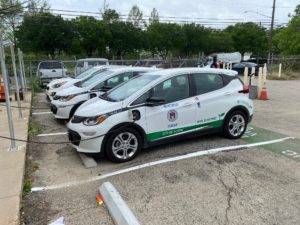
By Fleet Management Weekly Staff
May 2, 2022
Like most government fleets, including cities all over the country, the city of Austin is pivoting towards electric vehicles. The city’s Fleet Mobility Services manages a comprehensive full life cycle management program for approximately 7,000 vehicles and pieces of equipment across the entire city, including emergency services as well as city owned utilities: water, electric, refuse, and public works.
 Notes Rick Harland, Assistant Director for Fleet Mobility Services, “We’ve got roughly about 25 different departments that we serve. Our functions are largely budget, acquisition, make ready maintenance, and disposal. We own our own fuel system. We have about 45 different fuel sites. Our city fleet department is broken into three functional areas: Our service center operations, our emerging technologies division, which is where I work, and our business operations side. We’ve got approximately 232 employees.”
Notes Rick Harland, Assistant Director for Fleet Mobility Services, “We’ve got roughly about 25 different departments that we serve. Our functions are largely budget, acquisition, make ready maintenance, and disposal. We own our own fuel system. We have about 45 different fuel sites. Our city fleet department is broken into three functional areas: Our service center operations, our emerging technologies division, which is where I work, and our business operations side. We’ve got approximately 232 employees.”
Emerging Technology Division
The Emerging Technology Division of the fleet department is working on a strategy of advanced automotive technology on multiple fronts, including alternative fuel programs, electric vehicles, telematics, and car sharing. Fleet Mobility Services has done a few pilots with artificial intelligence and predictive analytics regarding vehicle performance with the eventual goal of autonomous mobility. They also aim to use their shop technology to perform advanced diagnostics on a variety of vehicles from Fire Apparatus to their battery EV fleet.
The department is additionally focused on its environmental stewardship, working towards meeting the city of Austin’s sustainability goals. They aim to achieve this through efforts such as safety and risk mitigation programs, advanced driver assisted systems, telematics and driver feedback, and accident reduction. These efforts accumulate into a focused aim to contain costs, reduce fleet expenses, and increase efficiency.
Austin EV Fleet History
 Will O’Connor, Fleet Program Manager for City of Austin Fleet Mobility Services, Emerging Technology Division, cited a decade-long involvement with the EV space in conjunction with Austin Energy, the city-owned utility: “Austin Energy began installing EV charging stations in 2008/09, which is when their relationship with Charge Point first began. Currently Austin Energy is helping Fleet Mobility Services to install charging stations, working on the contracting side of the installation alongside Austin’s Public Works department.”
Will O’Connor, Fleet Program Manager for City of Austin Fleet Mobility Services, Emerging Technology Division, cited a decade-long involvement with the EV space in conjunction with Austin Energy, the city-owned utility: “Austin Energy began installing EV charging stations in 2008/09, which is when their relationship with Charge Point first began. Currently Austin Energy is helping Fleet Mobility Services to install charging stations, working on the contracting side of the installation alongside Austin’s Public Works department.”
The department began buying electric vehicles in 2013, beginning with Ford Focus EVs for the Parking Enforcement Division,” notes O’Connor. “A grant from the State Energy Controller’s Office allowed them to convert 33 generation three Priuses into plugin hybrids, before purchasing 25 Chevy Bolts in 2017 and many more plugin hybrid vehicles in the late 2010s.”
A recent resolution from the City Council helped establish their latest program, which raised the number of EVs in the fleet to 300-330. Their current efforts are leading them away from plugin hybrids and towards full battery electric vehicles.
Battery Electric Vehicle Program
 Thanks to a clear mandate from the city of Austin’s leadership on developing a BEV program, Fleet Mobility Services has plenty of momentum to make the transition to EVs. Together with Austin Energy and Public Works, they’re able to achieve a focused effort to bring onboard an initial pilot program of 330 battery electric vehicles.
Thanks to a clear mandate from the city of Austin’s leadership on developing a BEV program, Fleet Mobility Services has plenty of momentum to make the transition to EVs. Together with Austin Energy and Public Works, they’re able to achieve a focused effort to bring onboard an initial pilot program of 330 battery electric vehicles.
As it stands now, Fleet Mobility Services is currently 260 EVs into their objective. A white paper done several years ago showed that onboarding or replacing ICE vehicles with BEVs would save the city approximately $3.5 million over 10 years in fuel and maintenance costs. This has allowed them to launch their BEV program with full steam ahead.
Challenges with Maintenance and Hiring Techs
Due to the current labor shortage, there are distinct challenges in hiring and retaining techs in the automotive field. Fleet Mobility Services is focused on training its own techs through intern and vocational programs that reach down to high school students and bring them into the automotive industry.
Harland sums up the crux of the hiring problem: “Despite the long-standing belief that automotive techs hold rote, mechanical positions, today’s jobs have shifted to high-tech responsibilities requiring knowledge of computers, data, and analytics.”
“Despite the labor shortages and vacancies currently facing every industry, we expect to recruit, train and employ a high-quality work force ready to join the next stage of evolution for the automotive industry.”




